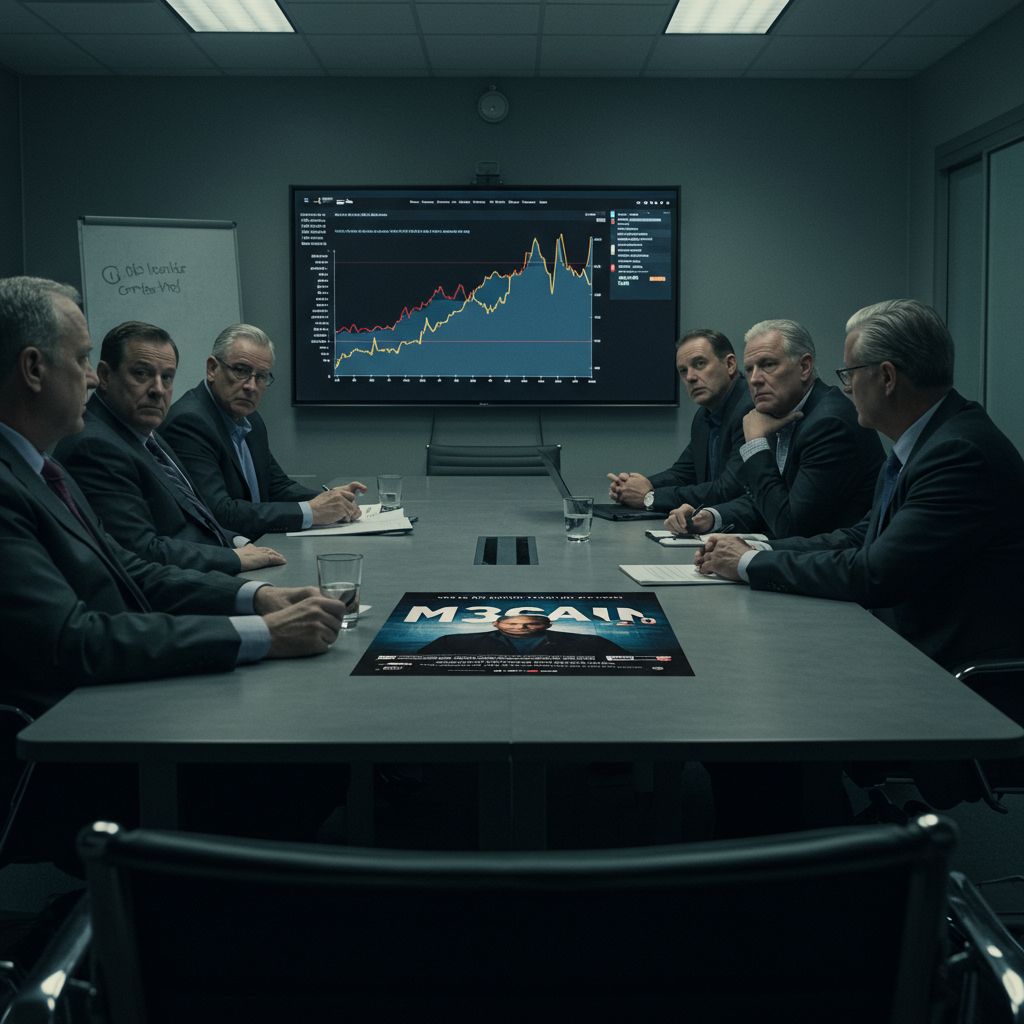<a href="https://news.quantosei.com/2025/06/30/brad-pitt-achieves-career-high-with-f1s-144-million-global-box-office-debut/” title=”Brad Pitt's F1 Movie Speeds to Career Record: 4M”>blumhouse Productions, a name synonymous with profitable, micro-budget horror hits, is currently navigating a challenging period. Following a string of unexpected box office disappointments starting in 2024 and extending into 2025, the studio is reportedly undergoing a significant reevaluation of its strategy. The most surprising setback came with the sequel M3GAN 2.0, which drastically underperformed compared to its highly successful predecessor, prompting a deep dive into what went wrong and how to navigate an evolving film landscape.
Jason Blum, the driving force behind Blumhouse, built his empire on the back of incredibly lucrative, low-cost genre films. His journey began after leaving Miramax in the early 2000s, fueled by a determination to succeed independently. A pivotal moment arrived with Oren Peli’s Paranormal Activity. Shot for less than $15,000, the film faced numerous rejections before catching the eye of Steven Spielberg, leading to a theatrical rollout that defied all expectations. Paranormal Activity went on to gross over $194 million globally, becoming one of Hollywood’s most profitable films ever and firmly establishing Blumhouse’s pioneering micro-budget model.
This success ushered in a “Golden Age” for low-cost horror. Blumhouse became the home for lucrative franchises like Insidious and The Purge. Partnering with Universal, the studio found continued success, even venturing beyond horror to produce acclaimed dramas like Spike Lee’s BlacKkKlansman and Jordan Peele’s Oscar-winning Get Out.
A Reversal of Fortune: The 2025 Box Office Slump
Despite its established track record, Blumhouse has encountered significant headwinds in 2025. All four of its theatrical releases have missed global box office projections: Wolf Man ($34.1 million), The Woman in the Yard ($23.3 million), and Drop ($28.6 million). While these figures might represent modest profits given their likely low budgets, they fall short of expectations.
The most striking underperformance, however, was M3GAN 2.0. The original M3GAN, released in January 2023, was a viral sensation. Made for just $12 million, it captivated audiences with its creepy AI doll concept, grossing $181.7 million worldwide. Expectations for the sequel were understandably high.
Why M3GAN 2.0 Stumbled
M3GAN 2.0 arrived with a production budget of at least $25 million before marketing. Its opening weekend in North America yielded only $10.2 million, contributing to a meager $17 million global debut. Industry analysts and insiders point to several critical factors behind this surprising failure.
The Genre Shift That Alienated Audiences
One primary reason cited for the sequel’s struggle was a deliberate creative choice to pivot its tone. Director Gerard Johnstone and the producing teams at Blumhouse and James Wan’s Atomic Monster opted to move M3GAN 2.0 towards a sci-fi action style, drawing comparisons to Terminator 2: Judgment Day. This significantly departed from the first film’s effective mix of horror, thriller, and dark comedy.
Audiences who connected with the original’s specific blend of scares and satirical commentary on technology were simply not interested in this new direction. As director Johnstone noted in an interview, he viewed the sequel as exploring M3GAN’s potential “redemption arc” as humans become “parents of AI,” but this thematic exploration wasn’t what the audience expected or wanted from a follow-up to a horror-comedy hit.
Poor Release Timing and Market Competition
The decision to release M3GAN 2.0 in the highly competitive summer corridor also drew criticism. The original film thrived in the less crowded January slot. Placing the sequel amidst major summer blockbusters created intense competition, potentially overshadowing the film and limiting its audience reach compared to the quieter release window that benefited the first movie. The summer box office, described by one analyst as a “cinematic gladiator school,” is proving a difficult environment for many films, not just horror.
Overconfidence and Brand Identity Missteps
Both internal reflections and external producer commentary highlight a degree of hubris. Jason Blum himself admitted on a podcast that the team “classically over-thought how powerful people’s engagement was with her [M3GAN].” They believed they could significantly alter the character’s genre and timing without consequence, treating M3GAN like a “Superman” figure adaptable to any scenario. This revealed a potential disconnect with understanding the core appeal of the first film and the audience’s desire for a direct continuation of that specific horror-thriller formula. One producer bluntly stated, “This was not the sequel audiences wanted. It was the movie that the director wanted.”
Blumhouse’s Internal “Soul Searching” Commences
The string of disappointments, particularly the M3GAN 2.0 failure, has triggered significant introspection within Blumhouse. Insiders report that a period of “soul-searching” is underway. The company is actively analyzing these recent results to inform future decisions.
A key area of reevaluation is the theatrical slate itself. There’s a recognition that the market for horror films, especially smaller, standalone titles, may be saturated. The ambition to release up to 10 theatrical features per year might be too aggressive for the current landscape. The company is questioning whether each film truly qualifies as a “cinematic event” in an era where audiences are selective about what they see in theaters.
Most importantly, Blumhouse is focused on a “course correction” to reaffirm its core horror brand identity. The lesson is clear: past formulas don’t guarantee future success, and understanding audience expectations for sequels and specific brands is crucial in a rapidly changing market.
Looking Ahead: Hope for the Future Slate
Despite the recent stumbles, Blumhouse has potential bright spots on the horizon. Hopes are particularly high for two upcoming sequels. October brings Black Phone 2, described as a “pure horror feature,” which aims to return to the genre’s roots. December features Five Nights at Freddy’s 2, following the massive success of the first film, which grossed nearly $300 million globally against a modest budget, becoming Blumhouse’s highest earner to date. Test audience reactions for the Five Nights at Freddy’s sequel are reportedly enthusiastic.
Discussions are also ongoing regarding the entire upcoming slate, including the M3GAN 2.0 spinoff SOULM8TE, scheduled for January 2026. While the M3GAN 2.0 performance raises questions, insiders note that SOULM8TE, centered on an adult AI companion robot, has tested “incredibly well,” suggesting potential for the AI concept in a different format or tone.
Universal’s Perspective and Long-Term Stability
Notably, Universal Pictures, Blumhouse’s primary studio partner, is reportedly not panicking over the recent performance. Studio insiders point to Blumhouse’s consistent fiscal responsibility. Their films are made for significantly lower budgets than most studio productions, mitigating the financial risk of any single failure. As one insider put it, “At the end of the day, every one of these movies will make money” over their full lifecycle across various distribution windows.
Blumhouse’s overall track record remains impressive. Since its founding in 2002, the company’s 42 releases have collectively grossed over $6 billion worldwide, with the vast majority produced for less than $20 million. Jason Blum himself views the current period philosophically, noting that slumps are a natural part of the journey for any major talent or company.
The M3GAN 2.0 failure serves as a stark reminder that even successful formulas and beloved characters aren’t immune to missteps in creative direction or market timing. The lessons learned about audience expectations, brand fidelity, and the limits of market capacity for genre films will undoubtedly shape Blumhouse’s strategy as it navigates the rest of 2025 and beyond, aiming to restore the luster to its renowned horror brand.
Frequently Asked Questions
Why did M3GAN 2.0 underperform at the box office compared to the first film?
M3GAN 2.0 struggled due to a few key factors. A primary issue was the creative decision to shift the sequel towards a sci-fi action genre, departing from the original’s popular horror-thriller tone. Audiences expected more of what made the first film a hit and weren’t interested in this change. Additionally, releasing the sequel in the crowded summer movie season, unlike the original’s successful January debut, exposed it to much stiffer competition.
What upcoming movies is Blumhouse releasing after its recent slump?
Blumhouse has several films slated, with particular focus on upcoming sequels in successful horror franchises. Key anticipated releases include Black Phone 2, scheduled for October, which is described as a traditional horror film. Following that is Five Nights at Freddy’s 2 in December, based on the popular game series, which saw massive success with its first installment. The M3GAN universe may also continue with the SOULM8TE spinoff in January 2026.
What lessons is Blumhouse taking away from its recent box office challenges?
Blumhouse is undergoing internal “soul searching” and reevaluating its strategy. Key takeaways include understanding audience expectations for sequels and maintaining brand fidelity rather than drastically changing successful formulas. The company is also analyzing market saturation for horror films and reconsidering its ambitious release volume, recognizing that releasing too many titles may dilute audience interest. The goal is to ensure future projects feel like significant “cinematic events.”



